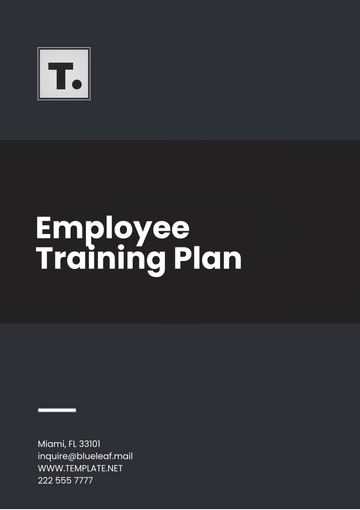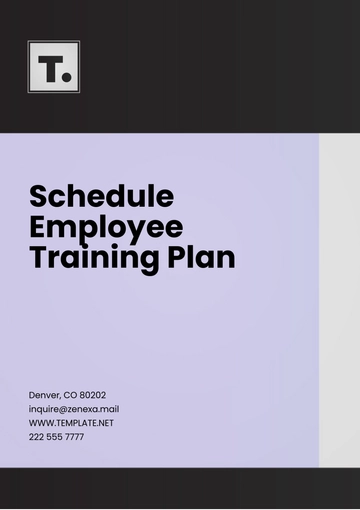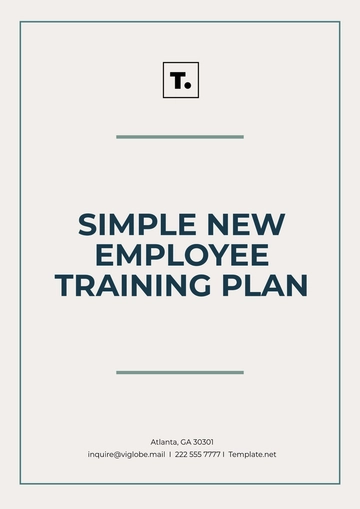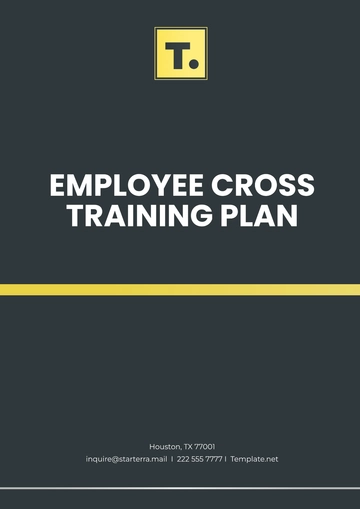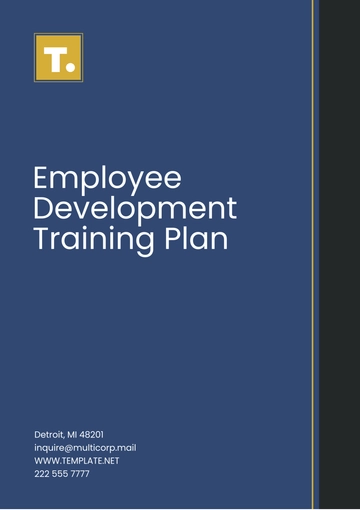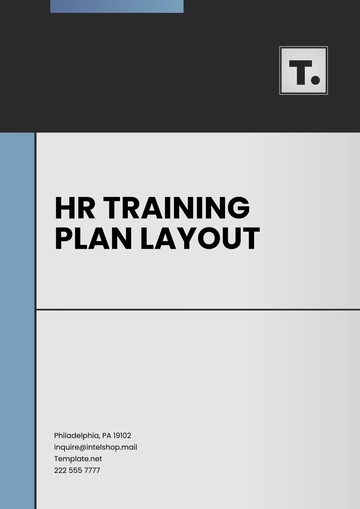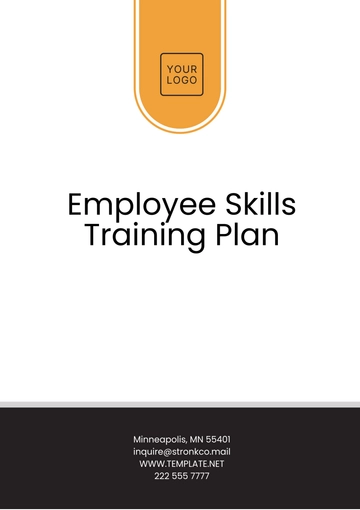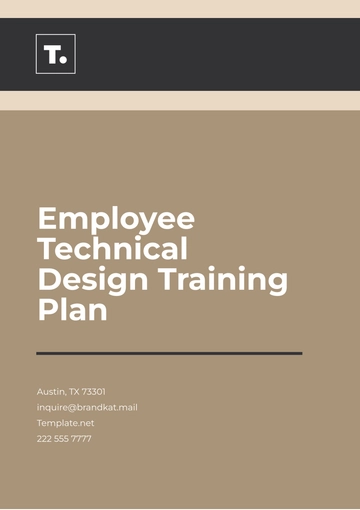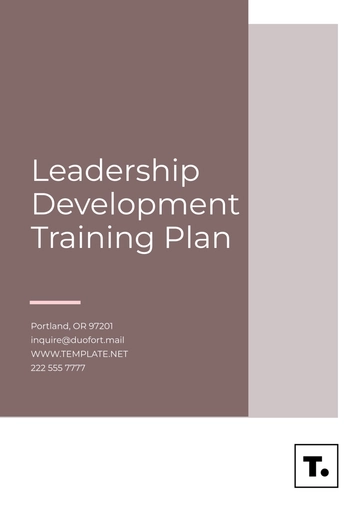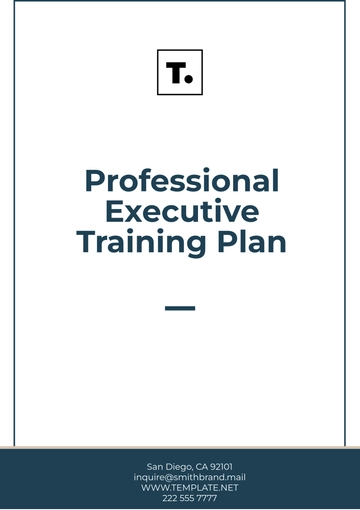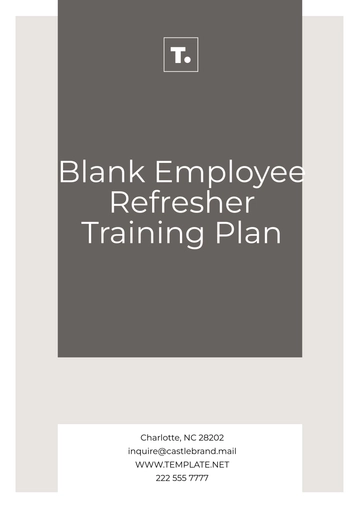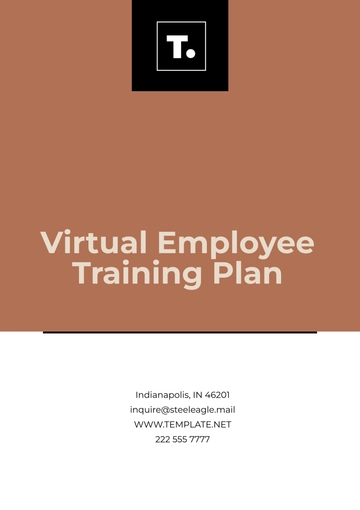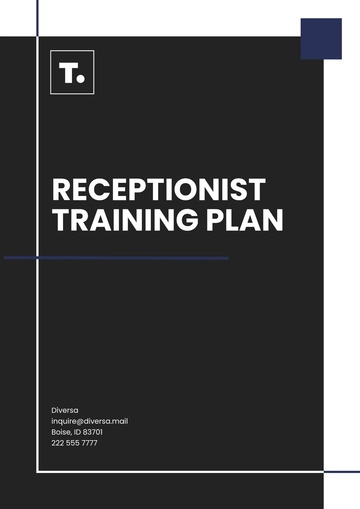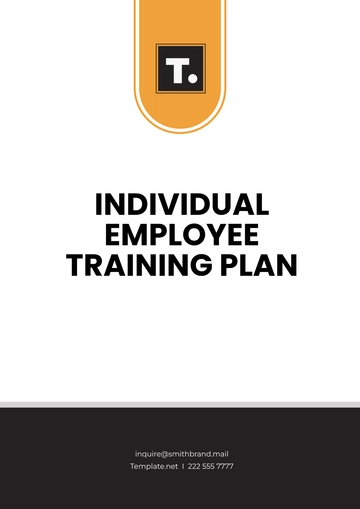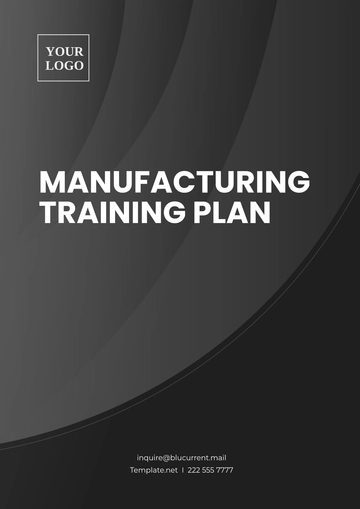Free Employee Training Plan
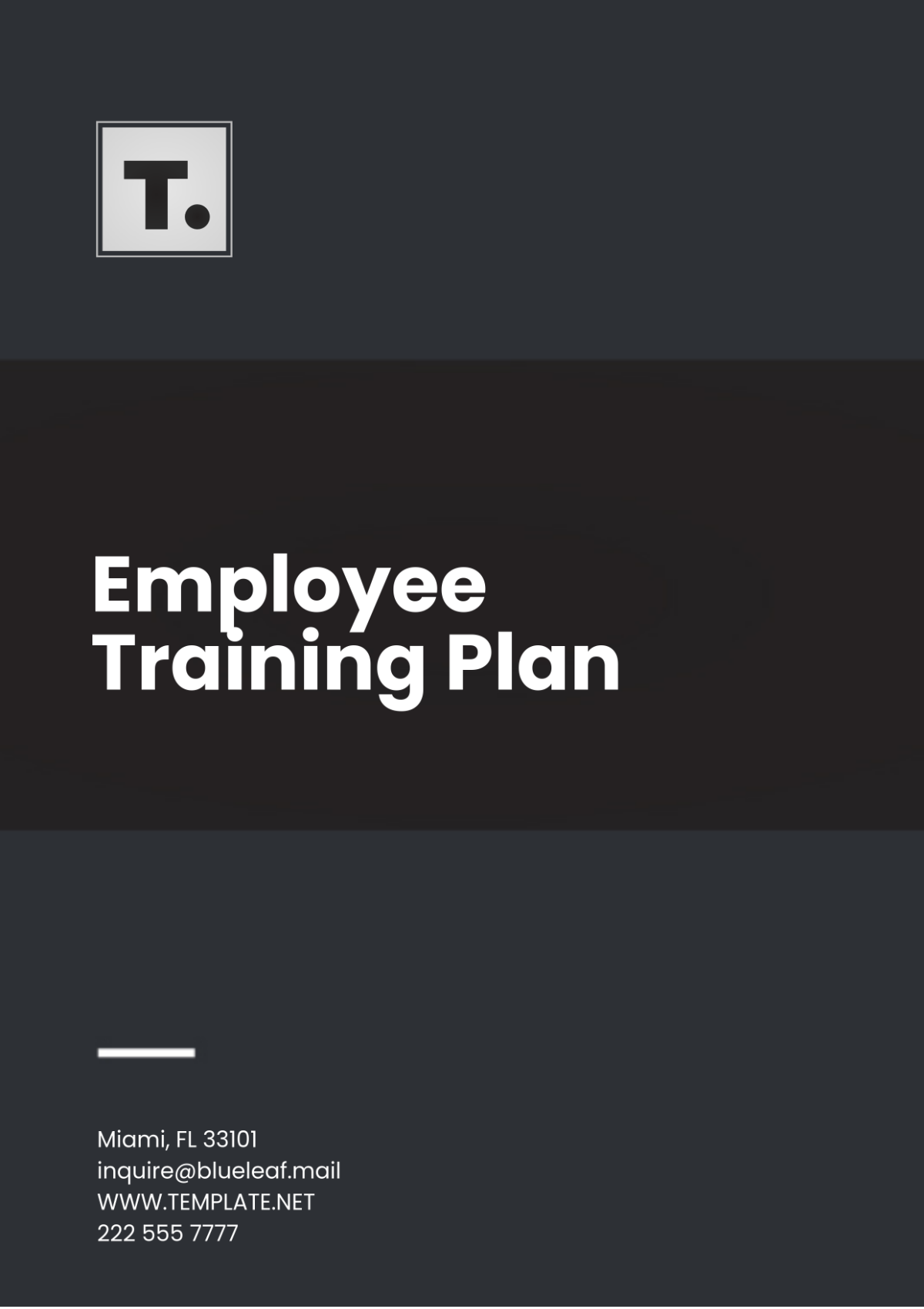
I. Introduction
In today’s competitive market, the success of a company depends significantly on the skills and capabilities of its workforce. An effective employee training plan equips employees to meet challenges, boost productivity, and align with organizational goals, fostering a culture of continuous improvement and professional growth.
II. Objectives of the Training Plan
Skill Enhancement
To improve employees' current skill levels, thereby increasing efficiency and productivity across departments.Compliance and Safety
To ensure employees understand and adhere to compliance protocols and safety procedures, fostering a secure workplace environment.Career Development
To support ongoing personal and professional growth, preparing employees for future roles and greater responsibilities within the organization.Innovation and Adaptability
To encourage creative thinking, adaptability, and problem-solving skills to keep pace with industry advancements.
III. Training Needs Assessment
Understanding the existing skill and knowledge gaps is essential for developing an effective training plan. The needs assessment will include:
Performance Metrics Analysis: Reviewing current employee performance to identify areas for improvement.
Feedback Collection: Gathering insights from employees and managers to tailor training to specific needs.
Industry Benchmarking: Comparing company standards with industry best practices to remain competitive and relevant.
Skill Gap Analysis: Identifying specific skills required for future roles, new technologies, or process improvements.
IV. Training Methodologies
A diverse approach to training will accommodate varied learning styles and maximize engagement. Key methods include:
On-the-Job Training
Employees learn through direct experience and observation, working alongside experienced colleagues.E-Learning Programs
Flexible online platforms allow employees to access training on demand, promoting self-paced learning and accessibility.Workshops and Seminars
Interactive sessions promote teamwork and offer hands-on experiences, ideal for collaborative learning.Mentoring and Coaching
Personalized guidance and feedback from mentors help employees develop skills specific to their roles and goals.
V. Roles and Responsibilities
To ensure successful execution, clear roles and responsibilities will be assigned to support the training program:
Training Managers: Oversee program development, delivery, and coordination of training resources.
Department Heads: Identify specific training needs within departments and support implementation.
HR and Learning & Development Teams: Facilitate scheduling, resource allocation, and follow-ups with participants.
Employees: Participate actively and provide feedback for continuous improvement.
VI. Budget Allocation
A budget plan is essential to cover costs related to training materials, external trainers, e-learning platforms, and travel (if required). This ensures the program is sustainable and resources are optimally allocated. A detailed breakdown will include:
E-Learning Platforms: Subscription and licensing fees for online courses and modules.
External Trainers and Consultants: Fees for expert-led sessions and specialized training.
Training Materials: Costs for manuals, digital resources, and equipment for hands-on learning.
Employee Incentives: Recognition and rewards for training participation and completion to boost morale and engagement.
VII. Training Schedule and Resources
Training will be organized quarterly to align with strategic goals, with resources assigned as detailed below:
Quarter | Training Focus | Resources |
|---|---|---|
Q1 | Compliance and Safety | Online Modules, Seminars |
Q2 | Skill Enhancement | Workshops, On-the-Job Training |
Q3 | Technology Upgrades | E-Learning, Technical Sessions |
Q4 | Career Development | Mentoring, Career Coaching |
VIII. Monitoring and Evaluation
To measure the effectiveness of the training plan and its impact on performance, the following evaluation strategies will be employed:
Pre and Post-Training Assessments: Assess knowledge or skill levels before and after training to gauge improvements.
Regular Feedback Sessions: Facilitate open feedback sessions with participants to understand their learning experiences.
Performance Review Post-Training: Assess how well employees apply new skills in their roles, with follow-up evaluations to track progress.
ROI Analysis: Calculate the return on investment by comparing training costs with improvements in productivity, efficiency, and employee retention.
IX. Continuous Improvement
Recognizing the need for ongoing development, the training plan will be reviewed regularly to incorporate advancements in industry practices, technology, and employee feedback. This approach ensures that the training program remains relevant and effective. Key actions for continuous improvement include:
Annual Review of Training Outcomes: Analyzing program results and updating strategies to align with evolving business goals.
Incorporating New Technologies: Adding new tools or platforms to enhance learning and engagement.
Employee Feedback Integration: Regularly gather and act on feedback to refine training content and delivery methods.
X. Conclusion
A well-structured training plan fosters a skilled, motivated, and forward-thinking workforce capable of achieving corporate objectives and adapting to new challenges. The organization reinforces its commitment to employee growth and excellence by continuously updating and refining the program.
- 100% Customizable, free editor
- Access 1 Million+ Templates, photo’s & graphics
- Download or share as a template
- Click and replace photos, graphics, text, backgrounds
- Resize, crop, AI write & more
- Access advanced editor
Optimize your employee development strategy with Template.net's Employee Training Plan Template. This fully customizable and editable resource lets you personalize training plans to fit your company’s needs. Easily modify content using our Ai Editor Tool, creating a tailored, professional training plan that enhances skill development and aligns with business goals in just minutes.
You may also like
- Finance Plan
- Construction Plan
- Sales Plan
- Development Plan
- Career Plan
- Budget Plan
- HR Plan
- Education Plan
- Transition Plan
- Work Plan
- Training Plan
- Communication Plan
- Operation Plan
- Health And Safety Plan
- Strategy Plan
- Professional Development Plan
- Advertising Plan
- Risk Management Plan
- Restaurant Plan
- School Plan
- Nursing Home Patient Care Plan
- Nursing Care Plan
- Plan Event
- Startup Plan
- Social Media Plan
- Staffing Plan
- Annual Plan
- Content Plan
- Payment Plan
- Implementation Plan
- Hotel Plan
- Workout Plan
- Accounting Plan
- Campaign Plan
- Essay Plan
- 30 60 90 Day Plan
- Research Plan
- Recruitment Plan
- 90 Day Plan
- Quarterly Plan
- Emergency Plan
- 5 Year Plan
- Gym Plan
- Personal Plan
- IT and Software Plan
- Treatment Plan
- Real Estate Plan
- Law Firm Plan
- Healthcare Plan
- Improvement Plan
- Media Plan
- 5 Year Business Plan
- Learning Plan
- Marketing Campaign Plan
- Travel Agency Plan
- Cleaning Services Plan
- Interior Design Plan
- Performance Plan
- PR Plan
- Birth Plan
- Life Plan
- SEO Plan
- Disaster Recovery Plan
- Continuity Plan
- Launch Plan
- Legal Plan
- Behavior Plan
- Performance Improvement Plan
- Salon Plan
- Security Plan
- Security Management Plan
- Employee Development Plan
- Quality Plan
- Service Improvement Plan
- Growth Plan
- Incident Response Plan
- Basketball Plan
- Emergency Action Plan
- Product Launch Plan
- Spa Plan
- Employee Training Plan
- Data Analysis Plan
- Employee Action Plan
- Territory Plan
- Audit Plan
- Classroom Plan
- Activity Plan
- Parenting Plan
- Care Plan
- Project Execution Plan
- Exercise Plan
- Internship Plan
- Software Development Plan
- Continuous Improvement Plan
- Leave Plan
- 90 Day Sales Plan
- Advertising Agency Plan
- Employee Transition Plan
- Smart Action Plan
- Workplace Safety Plan
- Behavior Change Plan
- Contingency Plan
- Continuity of Operations Plan
- Health Plan
- Quality Control Plan
- Self Plan
- Sports Development Plan
- Change Management Plan
- Ecommerce Plan
- Personal Financial Plan
- Process Improvement Plan
- 30-60-90 Day Sales Plan
- Crisis Management Plan
- Engagement Plan
- Execution Plan
- Pandemic Plan
- Quality Assurance Plan
- Service Continuity Plan
- Agile Project Plan
- Fundraising Plan
- Job Transition Plan
- Asset Maintenance Plan
- Maintenance Plan
- Software Test Plan
- Staff Training and Development Plan
- 3 Year Plan
- Brand Activation Plan
- Release Plan
- Resource Plan
- Risk Mitigation Plan
- Teacher Plan
- 30 60 90 Day Plan for New Manager
- Food Safety Plan
- Food Truck Plan
- Hiring Plan
- Quality Management Plan
- Wellness Plan
- Behavior Intervention Plan
- Bonus Plan
- Investment Plan
- Maternity Leave Plan
- Pandemic Response Plan
- Succession Planning
- Coaching Plan
- Configuration Management Plan
- Remote Work Plan
- Self Care Plan
- Teaching Plan
- 100-Day Plan
- HACCP Plan
- Student Plan
- Sustainability Plan
- 30 60 90 Day Plan for Interview
- Access Plan
- Site Specific Safety Plan
